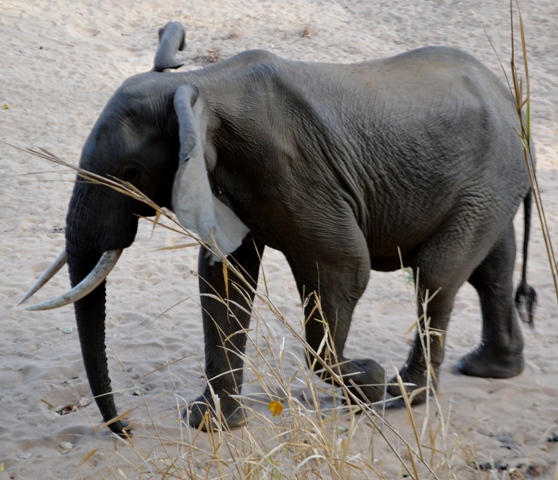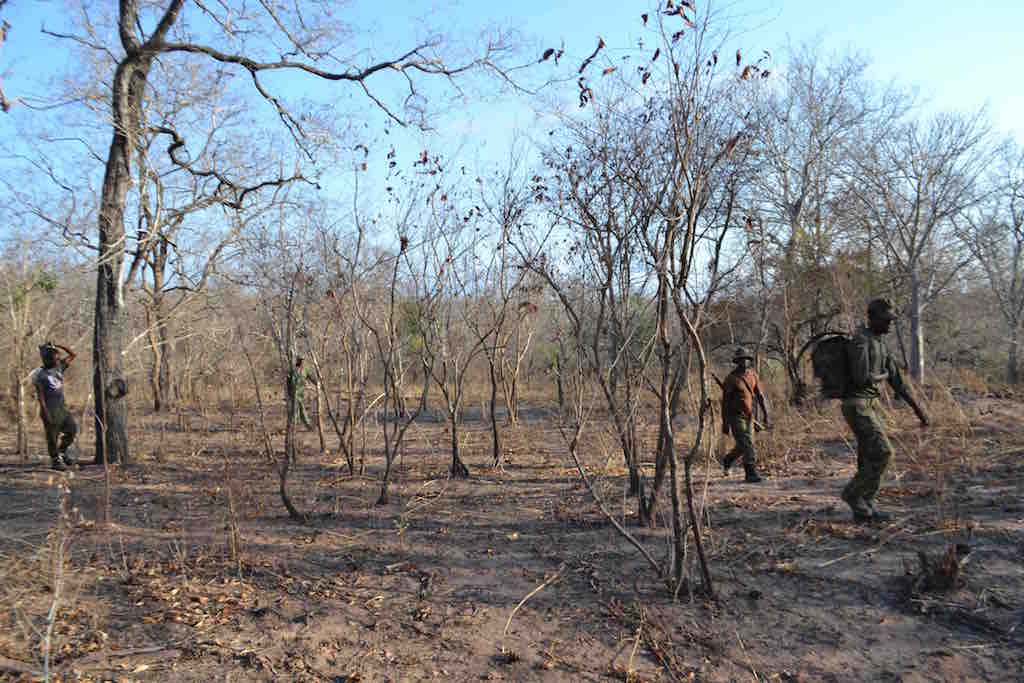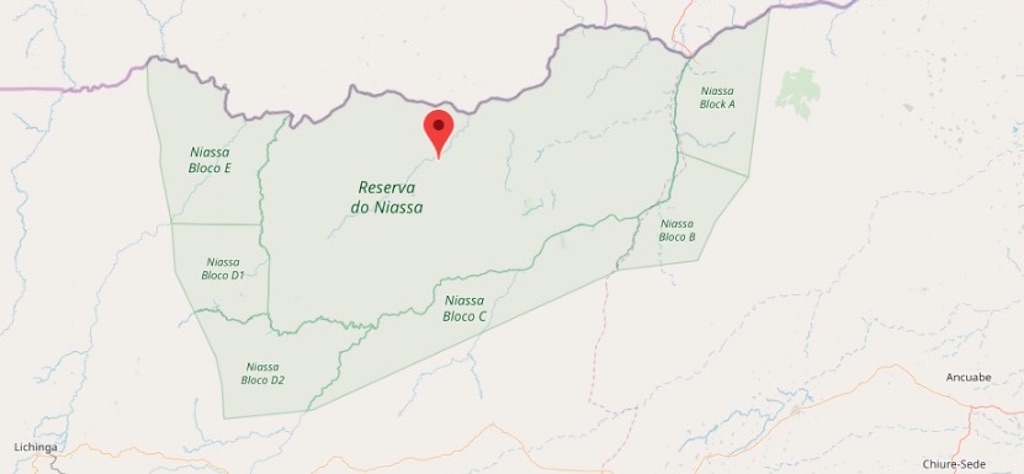
12 Sep Elephant carcasses pile up amid conservation tensions in Niassa
Rangers on the ground say a tug of war among decision makers is exposing Mozambique’s largest national reserve to poachers and ivory traffickers. Estacio Valoi investigates

Rangers fighting a wildfire in Niassa. They say poaching is still rampant in the national reserve. Photo: Estacio Valoi
On May 25 2019, during the celebration of the 8th anniversary of the creation of the National Administration of Conservation Areas (ANAC) in Mozambique, this institution announced that the country was registering a substantial reduction in elephant poaching and gave as an example the Niassa National Reserve, where it said a year had gone by without the slaying of elephants by poachers.
During the presentation, ANAC expressed concern about cases of individuals accused of committing environmental violations who were being released on bail and granted impunity even though they had committed crimes against wildlife with the involvement of Mozambican leaders.
Incessant poaching has in the past five years not only affected the pachyderms, but also “at least 65 leopards, 85 lions, 44 hyenas and 25 wild dogs which were slayed in Niassa Reserve”, ANAC said – a practice that according to sources on the ground hasn’t reduced. Niassa is situated in northern Mozambique and forms a transfrontier conservation area with the Selous Game Reserve in Tanzania.
According to management at the Lugenda Camp, part of the private Luwire Wildlife Conservancy inside Niassa, five old elephant carcasses had been found, but they were already registered in the database of the Wildlife Conservation Society some years ago.
However, this information is being contested by rangers working in Luwire and Niassa, who say it was a cover-up. “It’s lies,” say the rangers. “In the Luwire concession we found five elephant carcasses that were poached in the last three months of 2018.
“Two more carcasses have been found this year, which means there now seven carcasses. They are from this year, not from previous years as the Luwire-Lugenda Camp management said.”
According to the rangers, “No one does intensive anti-poaching operations. In the areas where elephants are poached there aren’t any rangers and no anti-poaching operations because of the new Luwire managers.”
In January 2018 ANAC recorded the number of rangers in Niassa – which covers 42,000 square kilometres, including the private operators’ areas – as 190, of which 90 were under the reserve’s administration. Recently Baldeu Chande, the reserve’s administrator, told an international media member that “the reserve has a total of 300 scouts [rangers]”.
This figure doesn’t match the information that Oxpeckers received, directly from the Luwire administration, that the number of rangers had currently reduced to 50: “We have 50 rangers. We expect to go back to 80 by the end of this year.”
The rangers on the ground say, “In 2018 Luwire fired about 30 rangers. At the time each one was earning a salary of 6,062 meticais [about R1,687].”

Luwire is a privately run wildlife conservancy in Niassa National Reserve, Mozambique’s largest game reserve that forms a transfrontier conservation area with the Selous Game Reserve in Tanzania. Source: luwire.org
Rapid Intervention Unit
According to the rangers, poaching has continued despite the presence of members of the Rapid Intervention Unit (FIR), who were introduced in Niassa after the first attacks allegedly by Al-Shabaab in Mocímboa da Praia.
Luwire addressed a letter to its rangers on December 24 2018 explaining why it had to terminate some working contracts: “In May 2018 President Jacinto Nyusi and Celso Correia [Minister of Land, Environment and Rural Development] intervened and introduced the special FIR in the reserve to execute some operations to fight poaching…
“As a consequence of this intervention of FIR and because there hasn’t been elephant poaching since March 2018… this drastic change means that, instead of Luwire having to focus on law enforcement, it can once turn its attention to its main mandate, which is hunting and wildlife safaris in Block-L.”
The rangers say elephants run away from the Kambako hunting concession in Niassa to the Luwire-Lugenda conservancy looking for protection. “In Kambako only guides are available for trophy hunters that come there. In the Kambako area, which borders Cabo Delgado, between Montepuez and Mueda, they do whatever they want.”
Tensions have arisen about Zimbabweans employed by Luwire. “With the new Luwire manager, John Nel, things became tough,” says one Mozambican ranger. “Luwire mistreats the rangers who have been fighting poachers for a long time. The only ones who have the right to a good salary are the Zimbabweans.
“A Zimbabwean technician earns 52,000 meticais [about R14,460 a month] against the 23,000 meticais [R6,400] the chief ranger gets, despite that he has done so much in this reserve. He sleeps badly and has no transportation, but a Zimbabwean has. Whoever complains is expelled, just like the rangers who were fired.”
The local rangers are also unhappy with their working conditions, which include total food provision of 12kg of maize flour, 12kg of beans and 12kg of rice to last for three months. “The foreigners have more rights than us, who do a lot of work. They reduced our salary. We are miserable, doomed,” says one.
Some local rangers asked the Mecula police commander to bring Correia and Niassa administrator Chande to sort out the problems, but they say ANAC blocked the move and that “Chande is sinking the reserve”.

Rangers say associates of Mateso Kasian, the mastermind of the poaching syndicate, have been released. Photo: supplied
Tug of war
Amid all these tensions, and a tug of war between the Wildlife Conservation Society and the Mozambican administration over Chande’s administration procedures, well-known poachers who were previously arrested are being released because of the lack of follow-up by the Niassa Reserve.
This includes associates of Mateso Albano Kasian, the poaching and trafficking mastermind who was arrested in July 2017 in a joint operation involving Niassa Reserve’s officials, ANAC and Mozambican Criminal Investigation Services with the Tanzanian authorities. Kasian was given an unspecified jail sentence in Mozambique in 2017 and was extradited to Tanzania, his home country, where he remains in jail.
His alleged associates were placed in the Niassa police cells in 2018, but have since been released. The rangers identified the suspects who have been released: “It was Rachado Fernando Araújo, Carlitos Jorge, Salmo Macho and Carlitos Rubaine, who were implicated in evidence involving the .375 of Mateso during the last operations of 2018.”
As for the 20% economic benefit share promised to local communities, training of staff and rehabilitation of conservation areas through the construction and maintenance of management infrastructure and the reintroduction of emblematic species for the attraction of tourism and ecosystem recovery, according to the rangers, “nothing has been paid”.
Questions sent to Luwire Wildlife Conservancy and the Niassa National Reserve about the issues raised by the rangers remained unanswered at the time of publication.
Estacio Valoi is a Mozambican journalist and Oxpeckers associate who assists the unit with transnational investigations into environmental problems in the sub-Saharan region, including the trafficking of ivory from northern Mozambique
